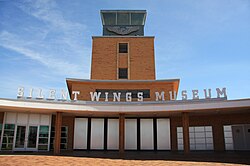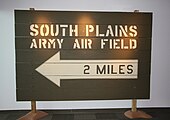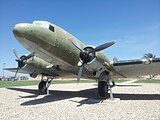
Lubbock Preston Smith International Airport is five miles north of Lubbock, in Lubbock County, Texas, United States. Originally Lubbock International Airport, it was renamed in 2004 for former Texas governor Preston E. Smith, an alumnus of Texas Tech University.
The Glider Pilot, Liaison Pilot, and Service Pilot badges were qualification badges of the United States Army Air Forces issued during the years of World War II to identify a rating in one of three specialized, limited-duty pilot categories whose selection and training differed from that of the traditional military pilot.

Waco Regional Airport is five miles northwest of Waco, in McLennan County, Texas. It is owned by the City of Waco.

Military gliders have been used by the militaries of various countries for carrying troops and heavy equipment to a combat zone, mainly during the Second World War. These engineless aircraft were towed into the air and most of the way to their target by military transport planes, e.g., C-47 Skytrain or Dakota, or bombers relegated to secondary activities, e.g., Short Stirling. Most military gliders do not soar, although there were attempts to build military sailplanes as well, such as the DFS 228.

Denton Enterprise Airport, also known as Denton Airport and previously Denton Municipal Airport, is a city-owned, public-use airport located three nautical miles (6 km) west of the central business district of Denton, a city in Denton County, Texas, United States.
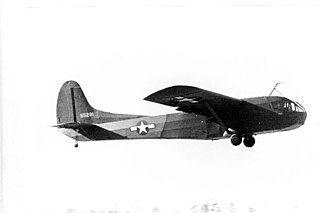
The Waco CG-15 was an American military glider, which was developed from the CG-4. Although outwardly similar to its predecessor and carrying the same number of passengers, a number of changes in the design, including shortened wings and a more streamlined nose enabled it to travel faster. 1,000 were ordered and 473 were delivered before production ceased. Two were transferred to the Navy for testing as the XLR2W-1. One unit was converted into an XPG-3 powered glider which used two Jacobs R-755-9 radial engines.
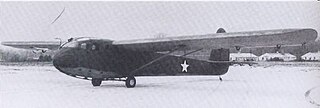
The Waco CG-3A was a US light troop military glider of World War II.

The Waco CG-4 was the most widely used American troop/cargo military glider of World War II. It was designated the CG-4A by the United States Army Air Forces, and given the service name Hadrian by the British.

The Waco CG-13 was an American military transport glider aircraft developed during World War II.

The Laister-Kauffmann TG-4 was a sailplane produced in the United States during the Second World War for training cargo glider pilots. It was a conventional sailplane design with a fuselage of steel tube construction and wooden wings and tail, covered all over with fabric. The pilot and instructor sat in tandem under a long canopy.

Dalhart Army Air Base is a former World War II military airfield complex near the city of Dalhart, Texas. It operated three training sites for the United States Army Air Forces from 1943 until 1945.

Laurinburg–Maxton Army Air Base is an inactive United States Air Force base, approximately 6 miles east-northeast of Laurinburg, North Carolina. It was active during World War II as a I Troop Carrier Command training airfield.
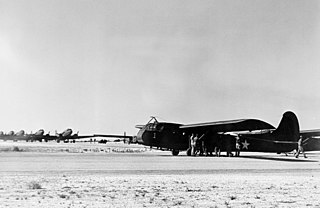
Big Spring Army Glider Training School is an abandoned facility located approximately 18 miles (29 km) north-northwest of Big Spring, Texas. It is now farmland and no trace of it exists.
Grand Forks Municipal Airport is a former airport, located within current city limits approximately 3 miles (4.8 km) west-northwest of central Grand Forks, North Dakota. It was closed shortly after World War II and is now redeveloped as part of the urban area of Grand Forks.
Hays Field was an airport located about 1.5 miles (2.4 km) east of Hays, a city in Ellis County, Kansas, United States. It was closed shortly after World War II and is now redeveloped as part of the urban area of the city.
Monticello Field is a former airport and military airfield in Big Lake Township, Minnesota, United States, approximately a mile northeast of Monticello. It is inactive.
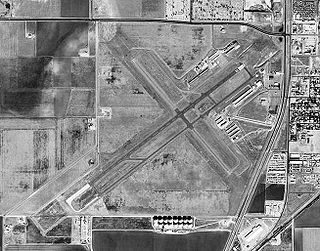
Hale County Airport is a public airport about 1 mile (1.6 km) south-southwest of Plainview, Texas.
Theldor Airfield was a temporary World War II airfield located approximately 4 miles (6.4 km) north-northeast of Vinita, Oklahoma. It was closed after World War II.

During World War II civilian flying schools, under government contract, provided a considerable part of the flying training effort undertaken by the United States Army Air Forces.

The 80th Flying Training Wing was a training wing of the United States Army Air Forces. It was last assigned to the Central Flying Training Command, and was disbanded on 16 June 1946 at Ellington Field, Texas.

